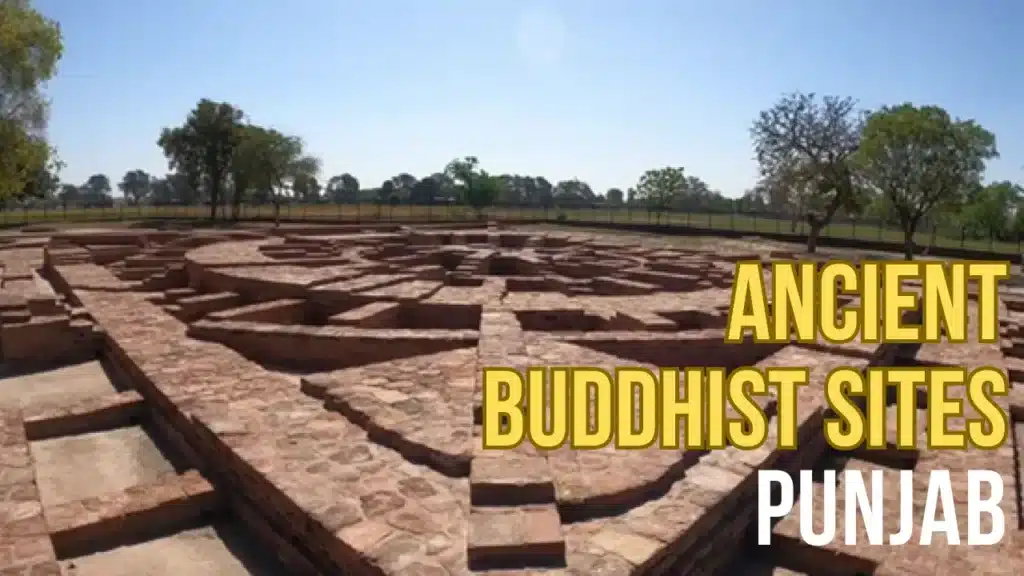The fertile plains of Punjab, often associated with the rich heritage of Sikhism, also hold a fascinating and significant, albeit less visible, Buddhist past. Buddhism arrived in Punjab directly through Buddha and became the dominant religion in the region for about 1000 years, starting roughly 300 years after Buddha’s Mahaparinirvana. During this period, Buddhist saints, scholars, poets, and philosophers enriched the culture of Punjab and influenced Buddhism in other parts of India. For over a millennium, from the time of Emperor Ashoka to the decline in the early medieval period, Buddhism flourished in this region, leaving behind a trail of stupas, monasteries, and artifacts. What remains today are only the ruins of the ancient Buddhist sites in Punjab.
Table of Contents
ToggleAccounts by Chinese Buddhist Monks and Scholars
Several Chinese Buddhist monks and scholars travelled to India between the 5th and 7th centuries CE, seeking Buddhist scriptures, knowledge, and to visit holy sites. Key figures include Fa-Xian, Xuanzang, and Yijing, each leaving behind valuable accounts of their journeys and observations of Indian society and Buddhism during their time. Xuanzang and Faxian, who traversed these lands centuries ago, documented a vibrant Buddhist landscape teeming with monks and centers of learning. Hiuen Tsang noted 50 Viharas and about 2000 Bhikkhus in Jalandhara, 3 Viharas and around 700 Bhikkhus in Thaneswar, and 20 Viharas with about 1000 Bhikkhus in Kulu. While much of this history lies buried beneath modern settlements or has been lost to time and subsequent cultural shifts, archaeological excavations have slowly begun to reveal the profound impact of the Dharma on the land of the five rivers.
This article delves into some of the most notable ancient Buddhist sites in Punjab, exploring their historical significance, geographical context, and the factors contributing to their eventual decline.
Sanghol (Uchha Pind), District Fatehgarh Sahib
Sanghol, locally known as Uchha Pind (“high village”), is situated in the Fatehgarh Sahib district of Punjab, approximately 40 km from Chandigarh on the Chandigarh-Ludhiana highway. It lies on the ancient trade route of Uttarapatha, which connected Taxila with Mathura, making it a crucial stop for traders and pilgrims.

History and Significance
Sanghol is undoubtedly the most significant and extensively excavated ancient Buddhist site in Punjab. Archaeological excavations carried out by the Department of Archaeology & Museums, Punjab, and the Archaeological Survey of India (ASI) from 1968 to 1990 revealed a remarkable cultural sequence, from the Late Harappan period (circa 2000 BCE) to the medieval period. However, it was during the Kushan period (1st-3rd century CE) that Sanghol truly flourished as a prominent center of Buddhist architecture and art. Excavations at a mound known as SGL-5 unearthed a Dharma-chakra pattern plan of a Buddhist stupa, along with a circumambulatory platform and concentric walls. This stupa contained bone relics of a revered Buddhist teacher, interred in a soapstone casket bearing a Kharoshthi inscription.
The site gained immense prominence in 1985 with the accidental discovery of a treasure trove of 117 beautifully carved stone slabs, including 69 upright pillars, 35 crossbars, and 13 coping stones. These exquisite sculptures, belonging to the Mathura school of art from the 1st-2nd century CE, depict various Buddhist themes, Jataka tales, and figures of Yakshis and Salabhanjikas. They are now housed in the Sanghol Museum, offering a rare glimpse into the artistic sophistication of the period. Evidence of fortification with three moats and palatial remains from the Kushana period has also been found, indicating a fortified town alongside the monastic complex.
Reasons for its Decline
The decline of Sanghol, and Buddhism in Punjab generally was a multifaceted process:
Huna Invasions
The invasions by the Hunas (Huns) from the 5th century CE onwards were particularly devastating. Leaders like Toramana and Mihirakula were often hostile to Buddhism, leading to the destruction of monasteries and stupas across North India, including Punjab. Evidence of coins and seals related to Toramana and Mihirakula at Sanghol itself suggests their presence and potential destructive influence.
Shift in Royal Patronage
Over time, later dynasties and local rulers might have shifted their patronage away from Buddhism towards other religious traditions, particularly Hinduism (Vaishnavism and Shaivism) and later Sikhism.
Internal Decay
As with any religious institution, internal factors such as financial difficulties, decline in monastic discipline, or schisms could have contributed to its weakening.
Natural Calamities and Neglect
Earthquakes, floods, and centuries of neglect would have left the structures vulnerable, eventually leading to their ruin and burial under layers of earth.
How to Reach Sanghol
Sanghol is easily accessible by road from Chandigarh and Ludhiana. It’s about 40 km from Chandigarh and can be reached by taxi or bus. The excavated site and the Sanghol Museum are open to the public (closed on Mondays).
Buddhist Sites in Jalandhar
History and Significance
Jalandhar holds a significant place in the Buddhist history of Punjab, primarily through the accounts of the Chinese pilgrim Xuanzang (Hiuen Tsang), who visited in the 7th century CE (around 635 CE). He described Jalandhar as a large and prosperous city, the capital of the Jalandhar kingdom (also known as Trigarta). Xuanzang noted the presence of about 50 Buddhist monasteries in Jalandhar, housing approximately 2,000 monks, mostly followers of the Mahayana school. He mentioned a well-known vihara called Nagardhana, where he resided for four months to study a commentary with the famous Buddhist scholar Venerable Chandravarma. The then-king of Jalandhar, Udito (or Wuddhi), was himself a Buddhist and an ally of Emperor Harsha, treating Xuanzang as a state guest. This indicates a thriving and royally patronized Buddhist community in Jalandhar during that period.
Why it was Destroyed
Huna Invasions and Subsequent Instability
While Jalandhar was still flourishing during Xuanzang’s visit, the broader region had already experienced the devastating impact of Huna invasions. The subsequent political fragmentation and conflicts, especially after Harsha’s empire declined, would have led to a gradual weakening of Buddhist institutions.
Rise of Hinduism
As in other parts of India, the Gupta and post-Gupta periods saw a resurgence of various Hindu traditions, often with royal backing, which could have gradually marginalized Buddhism.
Later Invasions and Islamization
From the 8th century onwards, and more profoundly from the 11th century with the Ghaznavid invasions, the region experienced significant Islamic conquests. These invasions often targeted existing religious structures, leading to widespread destruction and conversion. The monasteries and stupas of Jalandhar likely suffered heavily during these periods, and the subsequent establishment of Islamic rule led to the decline of pre-existing faiths.
Urban Development
As a continuously inhabited city, subsequent urban development over centuries would have built over or destroyed older structures, making archaeological identification challenging.
How to Reach
Jalandhar is a major city in Punjab, well-connected by road, rail, and air (via Amritsar or Ludhiana airports). While the ancient Buddhist structures are likely buried beneath the modern city, the city’s historical significance can be appreciated.
Chinapatti (Patti, Amritsar District)
Historical Significance
Chinapatti earned its name (“Chinese Settlement”) because it served as the winter residence for Chinese hostages captured by the Kushan emperor Kanishka I. This indicates a significant foreign presence and an important strategic location. Xuanzang also visited Chinapatti, noting the presence of ten monasteries full of monks. He stayed here for 14 months (January 634 to March 635 CE), studying the Abhidhamma Sastra with the renowned scholar Vinitaprabha. This highlights Chinapatti’s role as a center of Buddhist scholarship and a bridge between India and East Asia.
Reasons for Its Destruction and Decline
Decline of Kushan Power
The initial prominence linked to the Kushan empire would have faded with its decline.
Huna Invasions
The region of Punjab was heavily impacted by the Huna invasions, which were particularly destructive to Buddhist institutions.
Later Invasions and Religious Shifts
Similar to Jalandhar, subsequent waves of invasions and the gradual shift in the religious landscape would have led to the abandonment and destruction of monasteries.
Agricultural and Urban Expansion
As a fertile agricultural region and later a place of settlement, the ancient structures would have been gradually lost or built over.
How to Reach Chinapatti
Patti is a town in the Amritsar district, accessible by road from Amritsar city. Due to continuous habitation, visible ancient Buddhist remains are unlikely, but its historical significance remains in the records of the Chinese pilgrims.
Sunet, Ludhiana District
Historical Significance
Sunet is known as an ancient site with a large mound and ruins indicative of an old city. While not exclusively Buddhist, archaeological findings have yielded a variety of coins and artifacts, including those of the Yaudheyas (a republican confederacy, 2nd century BCE to 4th century CE) and later Kushan rulers. Importantly, coin moulds of Vasudeva (a Kushan ruler) along with Yaudheya coins have been found here, suggesting the Yaudheyas might have liberated this region from Kushana rule. While specific Buddhist monastic remains have not been extensively publicized as in Sanghol, the presence of these early historical periods and the general flourishing of Buddhism during the Kushan and post-Kushan eras in Punjab suggest the possibility of a Buddhist presence at Sunet, perhaps as a smaller center or a place of transient monastic activity along trade routes. Panini, the ancient grammarian, also mentions “Sunetra,” possibly referring to Sunet, indicating its antiquity.
Reasons of its Destruction and Decline
Political Changes
The region witnessed numerous political changes, with various powers rising and falling, which would have impacted any religious centers.
Lack of Continuous Patronage
Unlike major monastic complexes, smaller sites might have lacked consistent royal or community patronage to sustain them through turbulent times.
Agricultural Activity
As a village in a fertile region, centuries of agricultural activity could have easily covered or destroyed ancient remains.
How to Reach Sunet, Ludhiana
Sunet is a village located southwest of Ludhiana city in the Ludhiana district of Punjab, accessible by local transport. However, archaeological remains might be limited or require specific guidance.
Other Historically Mentioned Sites in Punjab
Several other places in ancient Punjab are mentioned in historical texts, particularly by Xuanzang, as having Buddhist communities or monasteries. While extensive archaeological evidence matching these descriptions in modern Punjab is scarce (often due to continuous habitation or the sites now being in Pakistan), their mention highlights the widespread nature of Buddhism in the region:
Srughna (modern Sugh, Haryana, close to the Punjab border)
Xuanzang mentioned a large stupa built by Ashoka here. Though technically in Haryana, it was part of the historical Punjab region.
Puruṣapura (Peshawar, Pakistan)
While not in modern Indian Punjab, it was the Kushan capital and a major Buddhist center where Kanishka built a towering stupa. Its influence would have directly impacted Punjab.
Taxila (Pakistan)
Another massive Buddhist learning center, whose proximity and historical connections directly influenced the spread and development of Buddhism in Indian Punjab.
Conclusion
The ancient Buddhist sites of Punjab, though often overshadowed by later historical developments, represent a crucial chapter in the spiritual and cultural narrative of the Indian subcontinent. From the meticulously excavated stupa and exquisite Mathura sculptures of Sanghol to the vibrant monastic centers described by Xuanzang in Jalandhar and Chinapatti, these remnants paint a picture of a region deeply intertwined with the spread of the Dharma. The decline of Buddhism in Punjab, influenced by devastating invasions, shifts in royal patronage, and the natural ebb and flow of religious demographics, led to the abandonment and decay of these once-thriving centers. Yet, through dedicated archaeological efforts and the invaluable accounts of ancient pilgrims, the whispers of an enlightened past continue to emerge from the fertile soil, inviting us to rediscover the profound Buddhist legacy that once shaped the heartland of Punjab.
Further Reading –
Reference and Historical Texts
Xuanzang’s Records (Si-Yu-Ki). The travelogues of Xuanzang (Hiuen Tsang) are primary sources for the state of Buddhism in 7th century India, including Punjab. While a direct, comprehensive online public domain link to a specific translation can be elusive, here’s a general reference to his work:
Xuanzang (Hiuen Tsang). Si-Yu-Ki: Buddhist Records of the Western World (Translated by Samuel Beal). You can often find this on archive.org or other public domain book repositories by searching for the title and translator.
Reference in academic contexts: Many academic articles (like the ones below) will cite Xuanzang’s accounts, providing snippets relevant to Jalandhar and Chinapatti.
Google Arts & Culture (Travels of Xuanzang)
Faxian’s Records (A Record of Buddhist Kingdoms): Another crucial Chinese pilgrim whose accounts shed light on earlier Buddhist presence (early 5th century CE).
EBSCO Research Starters (Faxian Travels to India)
Academic Articles on Buddhism in Punjab:
“Impact of Buddhism On Punjab” (Scribd Document): While a document on Scribd, it summarizes key aspects and cites various historical accounts related to Buddhism in Punjab, including Xuanzang’s observations.
“Buddhist Heritage in Ancient Punjab” (Velivada): This article specifically mentions Chinapatti and Jalandhar based on Hiuen Tsang’s accounts.
“1000 Years of Buddhism in Punjab” (Ancient Indians): This site frequently references Xuanzang’s details about the region.
Archaeological Survey of India (ASI) & Site-Specific Resources:
The Archaeological Survey of India (ASI) is the primary authority for archaeological work in India. Their publications are the most authoritative for excavation details.
Archaeological Survey of India (Official Website): While the main website doesn’t always have direct links to specific detailed reports for every site on its front page, it’s the authoritative body. You can search for publications or circle reports. https://www.asi.nic.in/
Sanghol (Uchha Pind):
“A Study of the Sanghol Sculptures…” (Heritage Journal of Multidisciplinary Studies in Archaeology): This academic paper provides in-depth details about the excavations at Sanghol, the Mathura sculptures, and the site’s historical periods. This is a strong source. https://www.heritageuniversityofkerala.com/JournalPDF/Volume8.1/60.pdf





